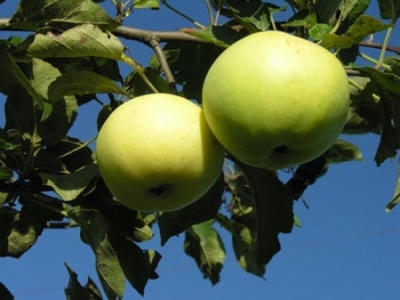
- Authors: M. A. Mazunin, N. F. Mazunina, V. I. Putyatin. South Ural Research Institute of Horticulture and Potato Growing
- Taste: sweet and sour, excellent
- Fruit weight, g: 140-170
- Fruit size: average
- Yield: up to 80 kg
- Frequency of fruiting: first years regular, then slightly periodic
- The beginning of fruiting varieties: 3-4 years after vaccination
- Ripening terms: winter
- Keeping quality: 120 days
- Appointment: universal
Dwarf fruit trees occupy an increasingly solid place and deserve every attention. One of the recent attractive options is the Snowdrop apple tree. For anyone, even a fairly experienced gardener, it will be useful to get to know her better.
Breeding history of the variety
The work on the Snowdrop was carried out by a team of breeders of the South Ural Research Institute of Fruit and Vegetable and Potato Growing. A significant role belongs to M. A. Mazunin, N. F. Mazunina and V. I. Putyatin. They took the Vydubetskaya weeping apple tree, more precisely, its genetic material, as a basis. She was subjected to free pollination. The result of the work carried out has satisfied even the most stringent requirements.
Description of the variety
The height of the apple tree can vary quite a bit. When using seed stock, it will reach 1.5-2 m. But if clonal stocks propagated vegetatively are used, then the range of heights will already be from 1.2 to 1.5 m. For Snowdrop, a flat horizontal crown is typical. The oblong-rounded foliage is large, dark green in color and heavily pubescent; moderately thick shoots are brown-green in color.
Features, pros and cons
The negative side of such an apple tree is the deterioration of the taste of the fruit towards the end of the shelf life. But this problem is completely counterbalanced:
the imminent appearance of apples;
decent frost and heat resistance;
the ability of the tree to recover from serious damage;
minimum requirements for soil quality;
pleasant appearance.
Ripening and fruiting
As pollinators for this variety, it is necessary to use apple trees of the Kovrovoye and Sokolovskoye varieties, Landing is also a good fit. Removable ripeness of fruits under normal growing conditions develops towards the end of September. The first apples can be enjoyed at 3 or 4 years of development. It is worth noting that a mature tree sometimes yields irregularly.
Growing regions
The variety is officially zoned for the Urals and West Siberian regions. There it became widespread. Experience shows that the cultivation of Snowdrop in the Moscow region is also very effective. You can grow it in more northern regions, but there are less chances of success. Fairly good prospects are found in the middle lane.
Yield
Up to 80 kg of fruit can be harvested from one tree without any problems. But with diligent efforts, it is not difficult to surpass this figure. Agronomists classify Snowdrop as a medium-yielding variety.
Fruits and their taste
Snowdrop apples are characterized by a light yellow color with the addition of a blurred reddish blush. The fruits resemble a rounded cone, the ribbing is weak. The weight of the fruit ranges from 140 to 170 g. Almost every eater likes the sweet and sour taste of apples. Other important features:
dry shiny peel;
white and firm flesh with a fine-grained structure;
content of dry soluble substances - 14.4%;
sugar content 9.2%;
the proportion of pectin substances 1.3% (in relation to the wet weight);
keeping quality up to 120 days.

Growing features
You can plant a Snowdrop in the spring, you just need to make sure that the soil is thoroughly warmed up. If the work is carried out in early autumn, then they choose the moment when there is still some time left before frost. During the autumn planting, covering work must be carried out. The site should be open, better oriented to the east or southeast. It is advisable to avoid clayey places where the apple tree will encounter difficulties.
To improve heavy soils, use:
humus;
peat;
expanded clay;
compost;
sawdust.



Top dressing
In the spring, the Snowdrop apple tree is fed with organic matter. Both the infusion of rotted cow dung and ash are used. These compounds are laid at the root. From time to time, foliar feeding is carried out with potassium sulfate and urea. This approach guarantees excellent tree development.


Diseases and pests
Apple tree Snowdrop does not suffer from scab. The risk of infection is close to zero even during the busiest seasons. Systematic fungicide treatments (1-2 times during the season) will also protect against other infections. The need for their treatment arises only due to violation of the rules of agricultural technology and the lack of preventive treatments.

The apple tree is a popular fruit crop among gardeners. It can be found in many summer cottages. But at the same time, such trees are often affected by various diseases. It is very important to recognize the disease in time and carry out the necessary procedures for a speedy recovery. Otherwise, the fruits will be spoiled, and the tree itself may die altogether.

Review overview
The main assessments of gardeners are as follows:
Snowdrop trees are strong and resilient;
they produce slightly less fruit than the advertisement promises;
it is necessary to carefully check the planting material being sold (it often does not meet the elementary requirements of some suppliers);
a decent frost resistance has been achieved;
the apple tree can be planted in underground waters close to the surface;
dwarf growth simplifies pruning, other plant care;
to keep the branches under load, it is necessary to use supports.











































































